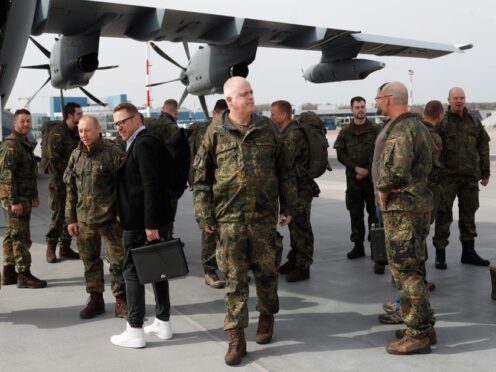Lithuanian leaders hailed a “historic event” as Germany on Monday began deploying troops in the Baltic country — a Nato member — marking the first time since the Second World War that German forces will be based outside the country on a long-term basis.
About two dozen soldiers arrived in Lithuania, laying the groundwork for a further 150 to join them later this year.
The deployment is expected to be up to its full strength of 5,000 by the end of 2027.
“This is the first time that we have permanently stationed such a unit outside of Germany,” German defence minister Boris Pistorius said in Berlin at a farewell ceremony for the preliminary command of Germany’s Lithuanian brigade, according to German news agency dpa.
Mr Pistorius called it “an important day for the German army”.

In the Lithuanian capital, Vilnius, defence minister Laurynas Kasciunas said that the move was “a great example” for all the countries on Nato’s eastern flank, on the border with Russia and its ally, Belarus.
“We will create such a defence and deterrence architecture that no adversary from the east will even think about testing Nato’s Article 5,” he told reporters.
Article 5 on collective defence is at the heart of the 32-member North Atlantic Treaty Organisation. It states that an armed attack against one or more of the members shall be considered an attack against all.
Some 4,800 soldiers and around 200 civilians with the German army will be stationed permanently in Lithuania, which is increasingly worried by its aggressive neighbours.
Under an agreement, Lithuania is preparing military bases for the German brigade to be deployed in this Baltic state bordering Russia’s Kaliningrad exclave to the west and Belarus to the east.
The German army, the Bundeswehr, has taken part in long-term operations abroad since the 1990s, first in the Balkans and then in combat operations in Afghanistan.
At the moment, the Bundeswehr says German soldiers are deployed in Europe, Asia and Africa, as well as in the Mediterranean.
However, this is the first permanent standalone German deployment, not on rotation as part of a multinational force.
Mr Kasciunas said the German brigade is expected to reach full operational capacity by 2027.
Lithuania chief of defence Valdemaras Rupsys said: “For us, this means more effective deterrence of the enemy and even greater security.
“It is an example of exceptional leadership and commitment as we actually see Nato’s collective defence and unity at work.”
Up to one-third of troops are expected to bring their family members, according to the Lithuanian Defence Ministry.
Mr Pistorius said Germany “will do everything we can to equip the brigade as it needs to be equipped from the outset”.
